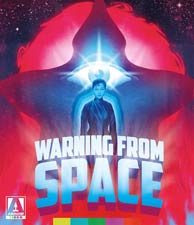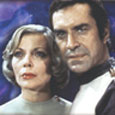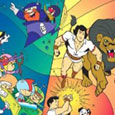Daiei (1956), Arrow Video (October 12, 2020), 1 Disc, 86 mins (US version is 88 minutes), 1:37:1 ratio, Dolby 1.0, Not Rated, Retail: $39.95
The Movie
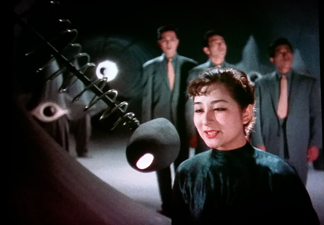 It may take a special type of science fiction fan to appreciate the wonders of Tokusatsu movies, the term for Japanese fantasy cinema – of which Warning From Spaceis an early example. Tokusatsu films may entail horror, monsters, and/or science fiction, but generally involve the use of special visual effects. Western viewers more accustomed to linear, rational storytelling can sometimes be a little confounded by the dreamlike logic and bizarre twists that these films can have, often made worse by bad attempts at dubbing them into English. Most of the general public is familiar with Godzilla as a character, though most people in the West probably don’t fully realize just what the creation of the monster brought about. Not only has Godzilla starred in over thirty Japanese films (including the recent anime seen on Netflix), his success resulted in a whole new film industry in Japan, unleashing a large number of movies and television shows about monsters and aliens. While many of these productions look pretty interesting, there is no doubt that they can also be confusing and strange.
It may take a special type of science fiction fan to appreciate the wonders of Tokusatsu movies, the term for Japanese fantasy cinema – of which Warning From Spaceis an early example. Tokusatsu films may entail horror, monsters, and/or science fiction, but generally involve the use of special visual effects. Western viewers more accustomed to linear, rational storytelling can sometimes be a little confounded by the dreamlike logic and bizarre twists that these films can have, often made worse by bad attempts at dubbing them into English. Most of the general public is familiar with Godzilla as a character, though most people in the West probably don’t fully realize just what the creation of the monster brought about. Not only has Godzilla starred in over thirty Japanese films (including the recent anime seen on Netflix), his success resulted in a whole new film industry in Japan, unleashing a large number of movies and television shows about monsters and aliens. While many of these productions look pretty interesting, there is no doubt that they can also be confusing and strange.
 In David Kalat’s excellent book A Critical History And Filmography Of Toho’s Godzilla Series, he explains some of the differences between Japanese and western culture, and how they relate to storytelling in film. While creators in the West favour logic, Japanese filmmakers may emphasize feelings and ideas, often dispelling with logic. Of course, American sci-fi films aren’t always totally adherent to logic either, whether one looks at the 1950s heyday of atomic, Cold War paranoia monster movies, or the effects-laden superhero blockbusters of today – but those Japanese movies can really be something else! Plots take off in different directions, sometimes without any real sense of cause-and-effect, odd happenings go unexplained, and one can tell that there are frequently aspects of Japanese myth and legend that enter into things, making it all somewhat impenetrable to the western viewer. Personally, though, I find these films incredibly fascinating and fun.
In David Kalat’s excellent book A Critical History And Filmography Of Toho’s Godzilla Series, he explains some of the differences between Japanese and western culture, and how they relate to storytelling in film. While creators in the West favour logic, Japanese filmmakers may emphasize feelings and ideas, often dispelling with logic. Of course, American sci-fi films aren’t always totally adherent to logic either, whether one looks at the 1950s heyday of atomic, Cold War paranoia monster movies, or the effects-laden superhero blockbusters of today – but those Japanese movies can really be something else! Plots take off in different directions, sometimes without any real sense of cause-and-effect, odd happenings go unexplained, and one can tell that there are frequently aspects of Japanese myth and legend that enter into things, making it all somewhat impenetrable to the western viewer. Personally, though, I find these films incredibly fascinating and fun.
 Prior to Arrow putting out their new Blu-ray of Warning From Space, I was familiar with the film only from seeing images of its preposterous starfish-like aliens, which I found more than a little reminiscent of the Justice League villain Starro The Conqueror, whom they fought in their first adventure in 1960 – which was actually a few years later! Seeing the frankly lame star-shaped costumes immediately puts one into a “camp” frame of mind. How can anyone take a film like that seriously, right? However, I had also read Stuart Galbraith’s Monsters Are Attacking Tokyo!, which seemed to indicate that Warning From Space was a much more earnest effort than what one might expect. I was intrigued. When I heard that the film had been prepared for an authorized Blu-ray, I was pretty excited to check it out.
Prior to Arrow putting out their new Blu-ray of Warning From Space, I was familiar with the film only from seeing images of its preposterous starfish-like aliens, which I found more than a little reminiscent of the Justice League villain Starro The Conqueror, whom they fought in their first adventure in 1960 – which was actually a few years later! Seeing the frankly lame star-shaped costumes immediately puts one into a “camp” frame of mind. How can anyone take a film like that seriously, right? However, I had also read Stuart Galbraith’s Monsters Are Attacking Tokyo!, which seemed to indicate that Warning From Space was a much more earnest effort than what one might expect. I was intrigued. When I heard that the film had been prepared for an authorized Blu-ray, I was pretty excited to check it out.
From the opening moments, when we meet two friends at an eating bar, Warning From Space evokes thoughts of George Pal’s 1953 classic The War Of The Worlds. Lights are seen in the sky, meteorites appear to fall to earth, and eventually strange creatures emerge and terrify the populous. Rather than the superbly intimidating aliens in The War Of The Worlds, however, we get the rather silly star-shaped creatures previously mentioned. That’s okay, though, because the serious tone of the film keeps one quite involved, and one can forgive some bad costuming.
 We come to know three great scientists and their families, though any attempts at characterization or personal growth are short-lived and ultimately quite subservient to the alien plot. For example, the daughter of one scientist has her choice of staying single questioned by her parents, but that storyline goes nowhere. Much more important is that the aliens turn out to be friendly, a message that is easier to take once they assume the forms of humans, including that of a famous, beautiful actress. At this point, my thoughts drifted more towards this movie being inspired a little by Invasion Of The Body Snatchers, also from 1956, though with more benevolent aliens. (Also, I recalled the later 1964 Godzilla movie Ghidorah, The Three-Headed Monster, where an alien entity appears as an Earth princess.)
We come to know three great scientists and their families, though any attempts at characterization or personal growth are short-lived and ultimately quite subservient to the alien plot. For example, the daughter of one scientist has her choice of staying single questioned by her parents, but that storyline goes nowhere. Much more important is that the aliens turn out to be friendly, a message that is easier to take once they assume the forms of humans, including that of a famous, beautiful actress. At this point, my thoughts drifted more towards this movie being inspired a little by Invasion Of The Body Snatchers, also from 1956, though with more benevolent aliens. (Also, I recalled the later 1964 Godzilla movie Ghidorah, The Three-Headed Monster, where an alien entity appears as an Earth princess.)
The aliens offer a sincere message of warning: mankind much change its destructive ways or risk the consequences. Naturally, the film then reminded me of 1951’s The Day The Earth Stood Still. But hang on! There is also a rogue planet headed towards earth, ready to smash it to smithereens. Ah, so now the movie has become When Worlds Collide (also produced by George Pal, from 1951)! Mankind will undoubtedly perish, unless the aliens can work with an Earth scientist, who has a secret formula which can potentially destroy the hurtling planet.
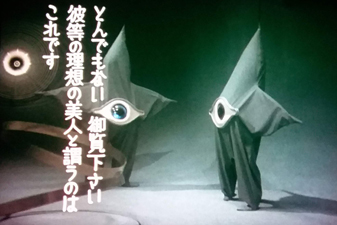 If it sounds like a real hodgepodge of plots and ideas, it is. But it’s also good fun, though all taken quite seriously. Those starfish aliens don’t really appear too much, which helps. The constantly evolving plot actually keeps things moving. If you get bored, don’t worry – the story is about to head into another direction!
If it sounds like a real hodgepodge of plots and ideas, it is. But it’s also good fun, though all taken quite seriously. Those starfish aliens don’t really appear too much, which helps. The constantly evolving plot actually keeps things moving. If you get bored, don’t worry – the story is about to head into another direction!
And I need to also mention one more instance of one film possibly inspiring another: Remember those spinning hoops seen on Krypton in Superman: The Movie? They appeared here first, on the alien star ship!
The Disc
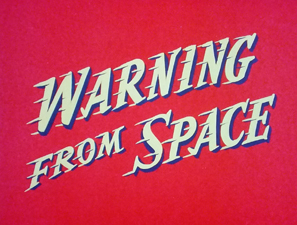 Arrow’s Blu-ray has a reversible cover, so one may switch it to showing an English-language film poster, though the new art on the standard cover is also quite nice.
Arrow’s Blu-ray has a reversible cover, so one may switch it to showing an English-language film poster, though the new art on the standard cover is also quite nice.
The disc contains both the Japanese version and the English-language version that was done for the American market. This US version was distributed by American International Television, and runs a little over a minute longer, perhaps mostly due to changes in the opening credits. The dubbing is okay, but there are the usual small differences in details or nuances that happen, making for an interesting comparison. I usually go for the original language version, but the dub is adequate.
 Public domain DVDs have in the past used pretty crummy prints for this film, so word of a Blu-ray presentation was quite exciting. Well, temper your expectations. This is still an old film, shot on what I would guess to be lesser film stock. The Blu-ray image is quite clean, at least, with barely any dust or print damage evident. Sharpness, however, comes and goes, depending on the shot, with a few shots bordering on blurry. There is also some faint flicker. Color values also vary, becoming faded at times. Mostly, though, it’s a more pleasing presentation than one might expect, given the circumstances, and some scenes really look quite good. The mono sound is actually quite clear, with no discernible hiss in either version.
Public domain DVDs have in the past used pretty crummy prints for this film, so word of a Blu-ray presentation was quite exciting. Well, temper your expectations. This is still an old film, shot on what I would guess to be lesser film stock. The Blu-ray image is quite clean, at least, with barely any dust or print damage evident. Sharpness, however, comes and goes, depending on the shot, with a few shots bordering on blurry. There is also some faint flicker. Color values also vary, becoming faded at times. Mostly, though, it’s a more pleasing presentation than one might expect, given the circumstances, and some scenes really look quite good. The mono sound is actually quite clear, with no discernible hiss in either version.
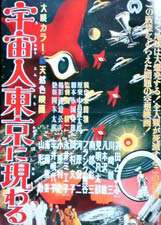 Looking at the extras, the aforementioned Stuart Galbraith IV provides a prepared, informative commentary that runs for a little over an hour, stopping just short of the complete film. No one knows Japanese cinema (especially Tokusatsu) like Galbraith, so it’s great that he could contribute. A teaser and theatrical trailer are here as well. The disc also contains a stills gallery, including many neat poster and lobby card images.
Looking at the extras, the aforementioned Stuart Galbraith IV provides a prepared, informative commentary that runs for a little over an hour, stopping just short of the complete film. No one knows Japanese cinema (especially Tokusatsu) like Galbraith, so it’s great that he could contribute. A teaser and theatrical trailer are here as well. The disc also contains a stills gallery, including many neat poster and lobby card images.
Cinematic Classic or Faded Print?
As the first true Japanese science fiction film to be filmed in color, Warning From Space does hold a certain place in film history. It’s not a great film, but it is a good one, and not at all campy once you get past the starfish pyjama suits. Lovers of Tokusatsu movies will find it a must-see, while fans of American ‘50s sci-fi will also find it engaging, if a bit derivative. Arrow’s disc does what it can with the faded elements, and gives the film by far its best representation in many years. With an informative commentary, the US version, a nice image gallery, and trailers, this is a satisfying disc for anyone inclined to check out this somewhat landmark film.



